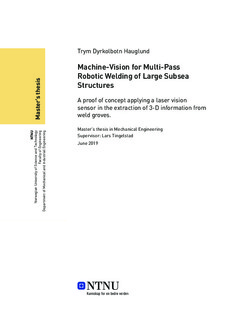| dc.contributor.advisor | Tingelstad, Lars | |
| dc.contributor.author | Dyrkolbotn Hauglund, Trym | |
| dc.date.accessioned | 2019-10-19T14:01:08Z | |
| dc.date.available | 2019-10-19T14:01:08Z | |
| dc.date.issued | 2019 | |
| dc.identifier.uri | http://hdl.handle.net/11250/2623329 | |
| dc.description.abstract | Denne masteroppgaven er en introduksjon til forskning og teori om temaer rundt laser trianguleringssensorer, robotisert sveising og datasyn. Det primære målet med oppgaven er å undersøke bruken av sensorikk som benytter seg av strukturerte lys for å inspisere overflater i robotisert sveising av flerlags sveis, som benyttes i produksjon av store offshore stål konstruksjoner. I tillegg blir også en laser trianguleringssensor utviklet og testet for å kunne identifisere ytelsesmål. Tidligere forskning samt kommersielle aktører innen robotisert sveising og lasersyn blir presentert og diskutert, hvor funn brukes som basis for å evaluere resultatene fra sluttesten. Teori og metoder for bruk av lasersyn sensorer blir også diskutert. Dette inkluderer beskrivelse av viktige systemparametere som arbeidsavstand, trianguleringsprinsipp og dybdeskarphet. I tillegg til grunnleggende teori innen robotikk og datasyn, så presenteres også metoder for kalibrering av
lasersyn sensorer. Dette inkluderer intrinsik og ekstrinsisk kalibrering av bildesensor, hånd-øye-kalibrering mellom bildesensor og robotens end-effektor, samt estimeringen av laserplan.
Et eksperimentelt oppsett av en lasersyn sensor som er montert på en industriell KUKA-robot blir presentert. Sensoren består av en Z-LASER Z18 linje laser og en industriell AT C4-2040 bildesensor som er i stand til å oppdage laserpunkt basert på avansert intern bildebehandling. Potensielle faktorer som kan ha en innvirkning på sensorens nøyaktighet presenteres og diskuteres. Fordi sensoren baserer seg på datasyn, så lider den av ekstern påvirkning fra arbeidsmiljøet slik som reflekterende overflater og lysforurensning. Enkle løsninger for å redusere slik påvirkning blir foreslått og testet i slutten av avhandlingen, hvor et bevis på konseptet blir presentert. Hovedmålet med sluttesten er å rekonstruere en nøyaktig 3-D-representasjon av en enkeltsveis som kan brukes til å parameterisere sveisen. De endelige resultatene blir vist å ha et avvik i dybdemåling på 0.7 mm, sammenlignet med tidligere oppnådde resultater på lignende prosjekter hvor det rapporterte gjennomsnittlige avviket ligger på < 0.5 mm. | |
| dc.description.abstract | This master's thesis serves as an introduction to the research and theory considering the subject of laser triangulation sensors, robotics and computer vision. The primary goal of the thesis is to examine the use of structured light sensors in robotic welding of large multi-pass weld groves as well as to develop and test a laser triangulation sensor on steel weld groves. Previous research, as well as commercial actors in the field of robotic welding and laser triangulation, are presented and used as basis to evaluate the results from the test at the end. Theory and methods regarding the operation of laser vision sensors which includes the description of important system parameters like working distance, the principle of triangulation and depth of field is also discussed in this thesis. Methods for calibration of laser vision sensor is also presented, which includes the intrinsic and extrinsic calibration of image sensors, hand-eye calibration between the image sensor and robot end-effector and the estimation of the laser plane.
An experimental setup of a laser vision sensor mounted on an industrial KUKA robot is developed where the sensor consists of a Z-LASER Z18 line laser and an industrial AT C4-2040 image sensor that is able to detect laser points based on advanced internal processing. Potential factors which might have an effect on the accuracy of the sensor is also presented and discussed. Because the sensor is vision based, it suffers from the effects of environmental factors like specular reflection and ambient light which becomes apparent through the initial testing. Simple solutions to mitigate these effects are proposed and tested out at the end of the thesis, where a proof of concept is presented with the main objectives to reconstruct an accurate 3-D representation of a single-v weld grove. The final test results of the laser vision sensor is shown to have a deviation in depth measurement of 0.7\ mm, compared to previously achieved results on similar projects where the reported mean deviation is <0.5 mm. | |
| dc.language | eng | |
| dc.publisher | NTNU | |
| dc.title | Maskinsyn i flerlags robotisert sveising av store subsea konstruksjoner | |
| dc.type | Master thesis | |
